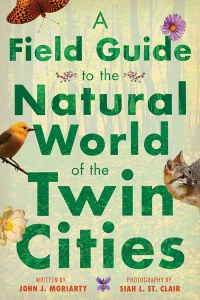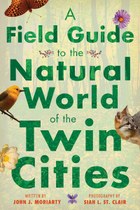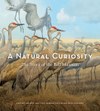A Field Guide to the Natural World of the Twin Cities
John J. Moriarty
Photography by Siah L. St. Clair

John J. Moriarty is a congenial expert on the remarkable diversity of plants and animals in the region’s habitats, from prairies and savannas to woods and wetlands, to fens and bogs, lakes and rivers, and urban and suburban spots. Featuring remarkable photographs, maps, and commentary on natural history, this field guide invites readers to investigate the Twin Cities’ wildlife.
This easy-to-use guide includes pictures of plants and animals arranged by regional parks, from chipmunks to garter snakes, invasive buck thorn to oak trees. It will enrich your admiration for these creatures and plants that thrive alongside 3 million humans in a ‘mosaic of various ecosystems.’
Pioneer Press
Though the Twin Cities and environs have proven a fine habitat for one particular species, the three million humans who call the area home share these 3,000 square miles with myriad animals and plants, all in a mosaic of various ecosystems. While most of the region’s wildlife has lost its original habitat to agriculture and urban development, a significant patchwork of native and restored habitat remains—prairies, woods, and wetlands, along with pockets in the parks and open spaces throughout the cities and suburbs. This easy-to-use guide gives novice and long-time naturalists alike the tools to find and explore these natural places in the metropolitan Twin Cities, some within the city limits and all within an hour’s drive of downtown Minneapolis.
John J. Moriarty is a congenial expert on the remarkable diversity of plants and animals in the region’s habitats, from prairies and savannas to woods and wetlands such as swamps and marshes, to fens and bogs, lakes and rivers, and urban and suburban spots. Featuring Siah L. St. Clair’s remarkable photographs, maps, and commentary on natural history, this field guide invites readers to investigate the Twin Cities’ wildlife—familiar and obscure, sun-loving or nocturnal, shy or easily observed. Here are snapping turtles, otters, and Cooper’s hawks, the wild lupines, white water lilies, and sprawling white oaks, among hundreds of species found in the wild, the park, or even the backyard. Including notes on invasive species and a list of references and organizations, this book is a perfect companion and an unparalleled resource for anyone interested in discovering the rich natural world of the Twin Cities.
$29.95 paper ISBN 978-1-5179-0549-1
432 pages, 380 color plates, 40 maps, 5 1/2 x 8 1/4, 2018

John J. Moriarty is senior manager of wildlife for the Three Rivers Park District. He has been a natural resources manager for the park systems of Ramsey and Hennepin counties and has been active in local natural history organizations. He is author of five books on Minnesota natural history, including, with Carol D. Hall, Amphibians and Reptiles in Minnesota (Minnesota, 2014).
Siah L. St. Clair was director of Springbrook Nature Center in Fridley, Minnesota, for thirty-five years. He serves on the board of directors of the Audubon Chapter of Minneapolis and has been involved in state and national environmental education and interpretation programs.

This easy-to-use guide includes pictures of plants and animals arranged by regional parks, from chipmunks to garter snakes, invasive buck thorn to oak trees. It will enrich your admiration for these creatures and plants that thrive alongside 3 million humans in a ‘mosaic of various ecosystems.’
Pioneer Press
Here is proof that you need not go beyond the boundaries of the metro area to find new and exciting natural places to visit, and fascinating to see.
Star Tribune
This easy-to-use guide gives novice and long-time naturalists alike the tools to find and explore these natural places in the Twin Cities metro.
Minnesota Outdoor News
This book is a perfect companion and an unparalleled resource for anyone interested in discovering the rich natural world of the Twin Cities.
Community Reporter
This a high quality guide for amateur naturalists in the Twin Cities region.
CHOICE
The book has an overview of the Twin Cities as a whole, then delves into specific habitats—prairies, savannas, big woods, oak woods, marshes and swamps, fens and bogs, lakes, rivers, and urban and suburban. Whether it is the invasive Chinese mystery snail or the cherished northern cardinal, the book covers the creatures found in those landscapes.
Eden Prairie News
Including notes on invasive species and a list of references and organizations, this book is a perfect companion and an unparalleled resource for anyone interested in discovering the rich natural world of the Twin Cities.
The Phoenix Spirit

Introduction
Prairies
Savannas
Big Woods
Oak Woods
Wetlands: Marshes and Swamps
Fens and Bogs
Lakes
Rivers
Urban and Suburban
Appendix A. Natural Areas and Parks by Habitat
Appendix B. Animals and Plants by Habitat
Checklist of Vertebrates of the Twin Cities
Resources
Index
About This Book
Related Publications
Related News & Events
Star Tribune Wingnut blog: A Field Guide to the Natural World of the Twin Cities.
Eden Prairie News: Documenting Twin Cities wildlife
Community Reporter: Horticulture as the art and science of growing
Star Tribune Wingnut blog: A Field Guide to the Natural World of the Twin Cities.
Buy two copies of this book. One for yourself, the other a gift.
Eden Prairie News: Documenting Twin Cities wildlife
The senior manager of wildlife for the Three Rivers Park District and the former director of the Springbrook Nature Center in Fridley have come together to create a book on the habitats and wildlife of the Twin Cities.
Community Reporter: Horticulture as the art and science of growing
Review of A FIELD GUIDE TO THE NATURAL WORLD OF THE TWIN CITIES.
KFAI: The Natural World of the Twin Cities
John J. Moriarty has written a Field Guide to the Natural World of the Twin Cities, published this year by University of Minnesota Press, and he recently joined Paul Brohaugh of KFAI's Poetry, Science and Wrestling to talk about the book.







